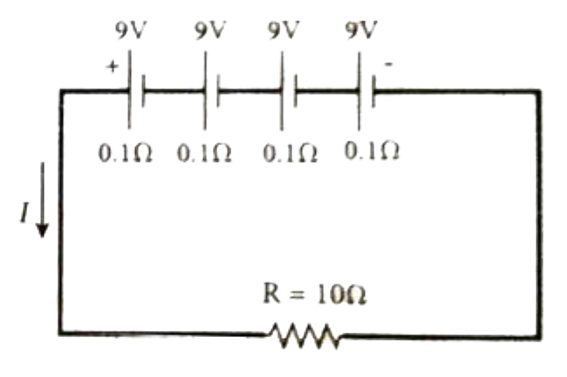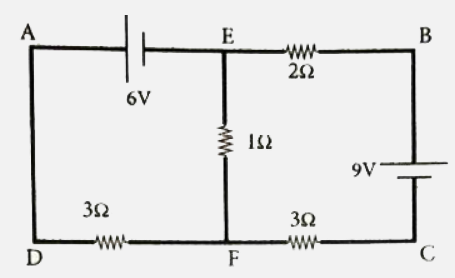Complete Solutions to In-Text Solved Examples of chapter CURRENT ELECTRICITY of Class 12 book with complete answers and questions
| Class 12 | PHYSICS |
| Chapter | CURRENT ELECTRICITY |
| FULL MARKS | In-Text Solved Examples |
| Number Of Questions | 28 |
| Academic Year | 2023-24 |
Compute the current in the wire if a charge of 120 C is flowing through a copper wire in 1 minute.
View SolutionIf a electric field of magnitude 570 N `C^(-1)`, is applied in the copper wire. find the acceleration experienced by the electron.
View SolutionA copper wire of cross-sectional area 0.5 `m m^(2)` carries a current of 0.2A. If the free electron density of copper is `8.4xx10^(28)m^(-3)` then compute the drift velocity of free electrons.
View SolutionDetermine the number of electrons flowing per second through a conductor, when a current of 32A flows through it.
View SolutionA potential difference across `24Omega` resistor is 12 V. What is the current through the resistor?
View SolutionThe resistance of a wire is `20Omega`. What will be new resistance, if it is stretched uniformly 8 times its original length?
View SolutionConsider a rectangular block of metal of height A, width B and length C as shown in the figure.

If a potential difference of V is applied between the two faces A and B of the block (figure (a)), the current `I_(AB)` is observed. Find the current that flows if the same potential difference V is applied between the two faces B and C of the block (figure(b)). Give your answers in terms of `I_(AB)`.
View SolutionCalculate the equivalent resistance in the following circuit and also find the current `I,I_(1) and I_(2)` in the given circuit.

View SolutionCalculate the equivalent resistance in the following circuit and also find the current `I,I_(1) and I_(2)` in the given circuit.

View SolutionWhen two resistances connected in series and parallel their equivalent resistances are `15Omega` and `(56)/(15)Omega` respectively. Find the individual resistances.
View SolutionCalculate the equivalent resistance betweeen A and B in the given circuit.

View SolutionFive resistors are connected in the configuration as shown in the figure. Calculate the equivalent resistance between the points a and b.

View SolutionIf the resistance of coil is `3Omega` at `20^(@)C` and `alpha=0.004//^(@)C` then determine its resistance t `100^(@)C`.
View SolutionResistance of a material at `10^(@)C` and `40^(@)C` are `45Omega` and `85Omega` respectively. Find its temperature co-efficient of resistance
View SolutionA battery of voltage V is connected to 30V bulb and 60 W bulb as shown in the figure. (a) Identify brightest bulb (b) which bulb has greater resistance? (c ) Suppose the two bulbs are connected in series, which bulb will glow brighter?

View SolutionTwo electric bulbs marked 20 W- 220 V and 100 W - 220 V are connected in series to 440 V supply. Which bulb will be fused?
View SolutionA battery has an emf of 12 V and connected to a resistor of `3Omega`. The current in the circuit is 3.93 A. Calculate (a) terminal voltage and the internal resistance of the battery (b) power delivered by the battery and power delivered to the resistor.
View SolutionFrom the given circuit,
Find
(i) Equivalent emf of the combination
(ii) Equivalent internal resistance
(iii) Total current
(iv) Potential difference across external resistance
(v) Potential difference across each cell

View SolutionFrom the given circuit
Find
(i) Equivalent emf
(ii) Equivalent internal resistance
(iii) Total current (I)
(iv) Potential difference across each cell
(v) Current from each cell

View SolutionFrom the given circuit find the value of I.

View SolutionThe following figure shows a complex network of conductors which can be divided into two closed loops like ACE and ABC. Apply Kirchoff's voltage rule.

View SolutionCalculate the current that flows in the `1Omega` resistor in the following circuit.

View SolutionIn a Wheatstone's bridge `P=100Omega, Q=1000Omega and R = 40Omega`. If the galvanometer shows zero deflection, determine the value of S.
View SolutionWhat is the value of x when the Wheatstone's network is balanced?
`P=500Omega, Q=800Omega, R=x+400, S=1000Omega`
View SolutionIn a meter bridge with a standard resistance of `15Omega` in the right gap, the ratio of balancing length is `3:2`. Find the value of the other resistance.
View SolutionIn a meter bridge, the value of resistance in the resistance box is `10Omega`. The balancing length is `l_(1)=55 cm`. Find the value of dunknown resistance.
View SolutionFind the heat energy produced in a resistance of `10Omega` when 5 A current flows through it for 5 minutes.
View SolutionAn electric heater of resistance `10Omega` connected to 220 V power supply is immersed in the water of 1 kg. How long the electrical heater has to be switched on to increase its temperature from `30^(@)C` to `60^(@)C`. (The specific heat of water is `s=4200J kg^(-1)`/C`)
View Solution
In-Text Solved Examples questions and complete solutions for chapter CURRENT ELECTRICITY of FULL MARKS PHYSICS (TAMIL ENGLISH) of Class 12
All Exercises from FULL MARKS Class 12 PHYSICS CURRENT ELECTRICITY
- Additional Questions Solved (Assertion and reason type)
- Additional Questions Solved (Choose the correct answer)
- Additional Questions Solved (Fill in the blanks)
- Additional Questions Solved (Long Answer Questions)
- Additional Questions Solved (Match the following)
- Additional Questions Solved (Numerical Problems)
- Additional Questions Solved (Short Answer Questions)
- In-Text Solved Examples
- TEXTBOOK EVALUATION (Choose the correct answer)
- TEXTBOOK EVALUATION (Long Answer Questions)
- TEXTBOOK EVALUATION (Numerical Problems)
- TEXTBOOK EVALUATION (Short Answer Questions)